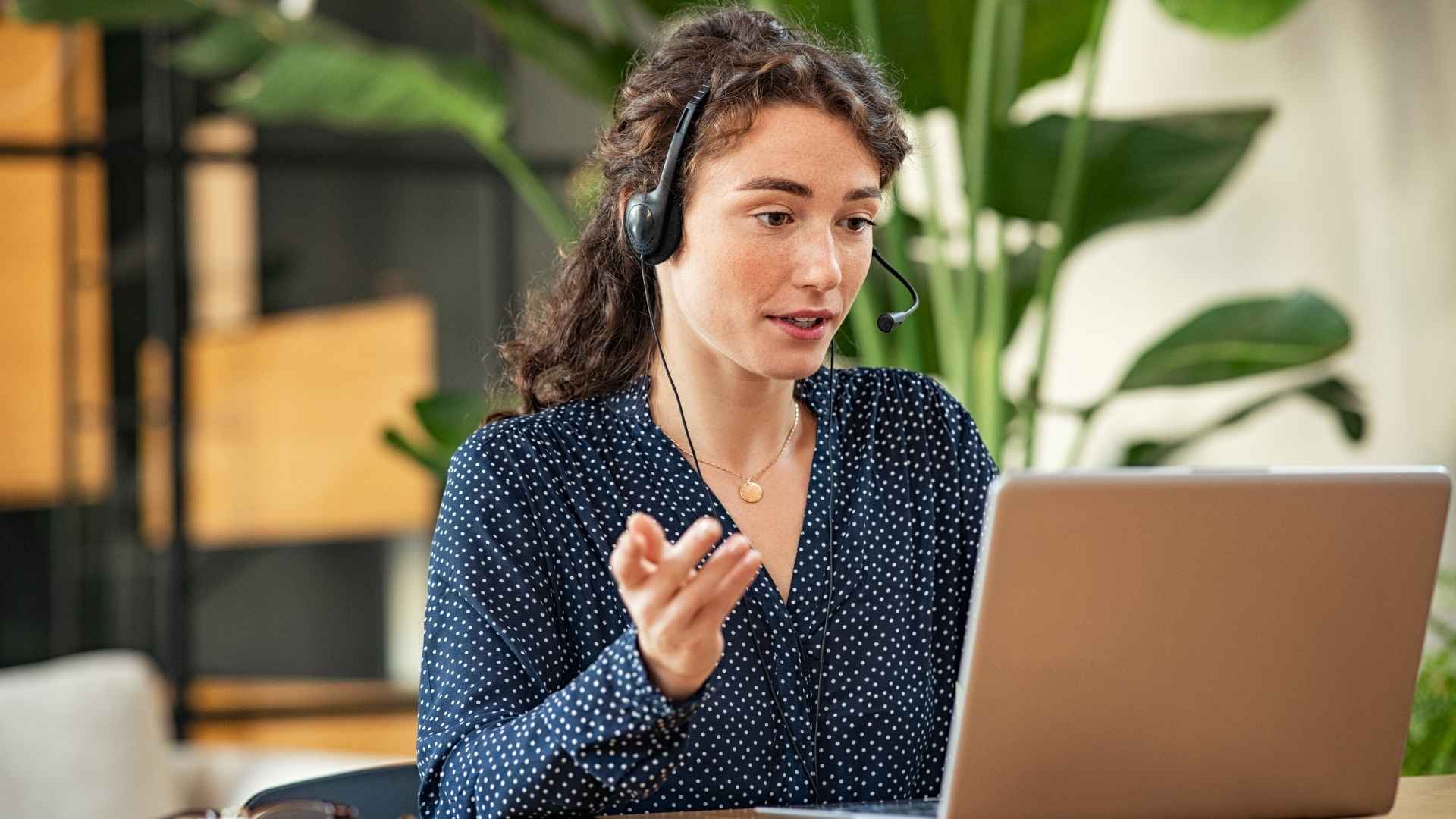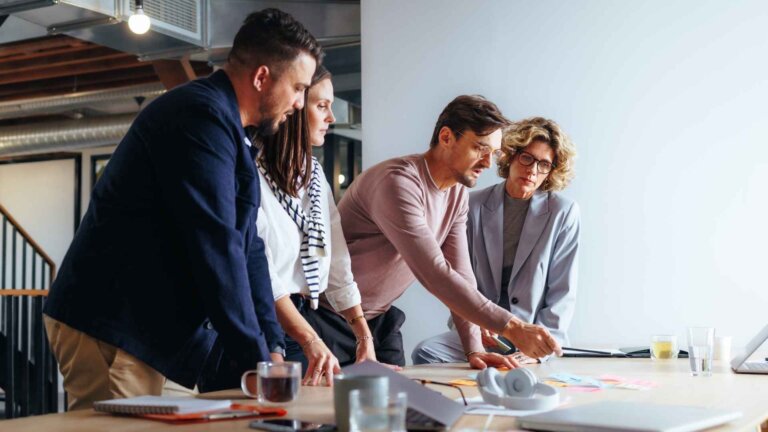After countless pitches on both sides of the table, one pattern holds: beautiful portfolios and big promises don’t predict outcomes. How a team thinks during vetting does. This isn’t about the “best” agency. It’s about the one that can understand and amplify YOUR business.
Select a web design firm by testing business understanding. Run five tests: homework (do they practice what they preach), discovery (do they ask or tell), depth (can they connect strategy to outcomes), alignment (how they handle real constraints), and integration (multi-stakeholder/technical fit). Favor teams that probe customers, sales motion, and success metrics, challenge weak ideas respectfully, and show curiosity about your model. They should make you feel challenged but not condescended to, educated but not overwhelmed. Most importantly, they demonstrate honesty about what success really requires.
What makes a great partnership
Great web design partnerships don’t start with design. They start with understanding.
The most successful projects share a pattern: The agency spent more time understanding the business than presenting solutions. They asked uncomfortable questions. They challenged assumptions. They admitted when something wasn’t their strength.
This requires vulnerability from both sides. The company shares real challenges, not just success stories. The agency stays honest about capabilities, timelines, and what success actually requires.
Most selection processes focus on the wrong indicators: portfolio beauty, award counts, client logos. These matter less than the quality of questions during discovery, the depth of strategic thinking, the honesty about constraints, and genuine curiosity about your business model.

The systematic vetting process
Selecting the right web design partner requires moving beyond gut feelings and portfolio reviews. You need a systematic approach that reveals true capability.
First, understand where agencies fall on The Capability Ladder:
Level 1: Order Taker – Says yes to everything, no strategic input
Level 2: Designer – Makes things beautiful, limited business thinking
Level 3: Problem Solver – Asks why before how, understands context
Level 4: Strategic Partner – Challenges assumptions, guides decisions
Level 5: Business Advisor – Sees broader implications, drives growth
You want partners at Level 4 or 5. Lower levels might execute well but won’t elevate your business.
We’ve developed a five-phase framework that surfaces the behaviors and capabilities that matter. This isn’t about finding perfection. It’s about finding alignment.
Phase 1 happens before any calls. Phase 2 tests their discovery process. Phase 3 reveals strategic depth. Phase 4 ensures alignment. Phase 5 evaluates integration capability.
Each phase builds on the previous one. Skip a phase and you might miss critical signals about partnership fit.
Phase 1: The homework phase
Before scheduling any calls, spend 30 minutes researching each agency. This preliminary homework reveals more than any sales pitch.
Start with their own website. Does it clearly communicate their unique value? Can you understand their approach in under two minutes? If they can’t articulate their own differentiation, how will they articulate yours?
Next, examine their content. Do they teach or just sell? Agencies that educate demonstrate strategic thinking. Look for depth, not just frequency. One thoughtful article beats fifty shallow posts.
Review their case studies critically. Do they explain strategic thinking or just show pretty pictures? Can you understand the business problem they solved, not just the aesthetic outcome?
Check their team page. Who actually works on projects? Many agencies showcase leadership but hide who does the work. You want to know if senior strategists are involved or if your project gets handed to junior staff immediately.
Finally, search for reviews beyond their website. Past client experiences, especially challenging ones, reveal how agencies handle real-world complexity.


Phase 2: The discovery call test
The discovery call reveals everything about an agency’s approach. Within 30 minutes, you’ll know if they’re order-takers or strategic thinkers.
Use The Discovery Call Scorecard to objectively evaluate:
Positive indicators (max +7):
- Asks about your business model: +2
- Asks about your customers: +2
- Asks about your internal process: +1
- Asks about success metrics/analytics: +1
- Uses clarifying questions to confirm understanding: +1
Concerning signs (max -3):
- Jumps to solutions without context: -1
- Talks more than listens: -1
- Promises outcomes before requirements are clear: -2
How to read it: Score only the first occurrence of each positive category to keep it objective. 5-7 = strong strategic partner, 3-4 = borderline, ≤2 = order-taker.
Strategic partners ask different questions. Instead of “What’s your favorite color?” they ask “How do customers typically find you?” Instead of “Do you like modern design?” they ask “What happens after someone converts on your site?”
Pay attention to follow-up questions. When you mention a challenge, do they dig deeper or move on? When you explain your business model, do they connect dots you hadn’t considered?
The best agencies make you think differently about your own business during the discovery call. They surface assumptions you didn’t know you had. This is one of the key agency evaluation criteria that separates true partners from vendors.
Phase 3: The depth test
After discovery, test their strategic thinking depth. This reveals whether they truly understand business or just make things look nice.
Ask them to explain the strategy behind a recent project. Listen for business reasoning, not just design rationale. Can they articulate why specific decisions drove business outcomes?
Use The Understanding Depth Test to evaluate their grasp of your business:
Level 1 – Surface Level: Can they repeat back what you told them?
Level 2 – Industry Level: Do they understand your competitive landscape?
Level 3 – Business Level: Can they articulate your business model?
Level 4 – Strategic Level: Do they see implications you haven’t considered?
You want partners operating at Level 3 or 4.
Present a real challenge from your business. See how they think through it. Do they immediately propose solutions, or do they ask clarifying questions first?
Request examples of projects that failed or faced significant challenges. Honest agencies share what they learned. Defensive agencies blame the client.
Ask about their process for making strategic recommendations. How do they validate assumptions? What research methods do they use? How do they handle stakeholder disagreement? Surface-level thinkers focus on aesthetics. Strategic partners see systems.

Phase 4: The alignment test
Misalignment causes more project failures than poor design. Test alignment early with specific scenarios.
Use The Expectation Alignment Test by presenting these situations:
Scenario 1: “We have a tight timeline.”
Do they immediately agree, or explore what’s driving the urgency? Strategic partners understand that artificial deadlines often mask deeper issues.
Scenario 2: “Our CEO has strong opinions about design.”
How do they plan to manage executive input while maintaining strategic integrity? Order-takers capitulate. Partners educate.
Scenario 3: “We’re not sure about our budget.”
Can they help you think through investment levels based on business goals? Or do they just send a rate card?
Scenario 4: “We want to look like our competitor.”
Do they dig into why, or just start copying? This question reveals whether they’ll challenge dangerous assumptions.
These scenarios reveal how agencies handle real project dynamics. You’re not looking for perfect answers. You’re looking for thoughtful approaches.
Share your real constraints: budget, timeline, internal resources, decision-making process. Watch how they respond. Do they problem-solve or just accommodate?
Discuss what happens when things go wrong. How do they handle scope creep? What if requirements change mid-project? What if a key stakeholder joins late? Their answers reveal their real-world experience.
Signs of a true strategic partner
Strategic partners reveal themselves through specific behaviors during the vetting process. Here’s what to look for.
They ask about your customers before your preferences. They want to understand who you’re serving, how you serve them, and what success looks like for them. Design preferences come later. (Spoiler alert: That’s exactly what separates strategists from stylists.)
They challenge your assumptions respectfully. When you say “we need a new website,” they ask why. When you request specific features, they explore the business goal behind them.
They admit limitations honestly. No agency excels at everything. Strategic partners refer you elsewhere when someone else is genuinely better suited. This honesty builds trust. We’ve done this ourselves countless times, and those clients often refer others back when we ARE the right fit.
They think in systems, not just pages. They ask about your sales process, customer journey, and business model. They see your website as one component of a larger business system.
They share their thinking transparently. They explain their reasoning, show their process, and include you in strategic decisions. No black box presentations or surprise revelations. (If they can’t explain their strategic thinking clearly, they might not have any.)
They talk about results, not just deliverables. Instead of “we’ll design 10 pages,” they discuss conversion improvements, lead quality, and business growth.
The questions that actually reveal capability
Beyond standard interview questions, these queries reveal true capability:
“Walk me through a project where the client’s vision conflicted with user needs. How did you handle it?” This reveals whether they’re order-takers or advisors.
“Tell me about a time when you recommended against what a client wanted.” Strategic partners aren’t afraid to provide honest counsel.
“How do you validate design decisions with data?” This separates opinion-driven from evidence-driven agencies.
“What would make you decline this project?” Agencies that work with everyone excel at nothing. Specialization indicates expertise.
“How do you handle it when a project isn’t meeting its goals?” This reveals their commitment to outcomes versus just delivery.
“What happens after launch?” Support promises are easy. Ask for specifics about training, documentation, and ongoing optimization.
“How do you stay current with industry changes?” Web design evolves rapidly. You want partners who invest in continuous learning.
“Can you explain your pricing model and what drives cost differences?” Transparency here predicts transparency throughout the project.


Understanding investment reality
Quality custom websites require significant time and expertise. When evaluating proposals, consider what level of strategic thinking, custom design, and development work can realistically be delivered at different price points. While it’s tempting to focus on price alone, understanding what you’re actually buying matters more than the number itself.
Investment Tiers (General Guidance):
Starter Approach ($15K-35K): Best for testing a new business model or quick market entry. Expect professional presence with essential functionality. At this level, you’re getting templates customized for your brand, not ground-up custom design.
Growth Investment ($40K-90K): Best for established businesses ready to compete on brand. Expect custom strategy, unique design, and solid foundation. This is where most mid-market companies find their sweet spot. You’re investing in differentiation, not just presence.
Strategic Platform ($100K+): Best for complex businesses with multiple stakeholders. Expect deep integration and sophisticated functionality. This level includes extensive research, custom development, and often multiple integrated systems.
These ranges vary by region, agency expertise, and project specifics. Use them as a starting point for conversations, not absolute rules. The key is understanding what’s realistic at each investment level.
Here’s an important truth: When simple makes more sense. If you need a web presence quickly and affordably, templates and builders can be the right choice. If you’re testing a business model, start simple. If you’re competing on operational excellence rather than brand differentiation, invest elsewhere. Not every business needs a complex custom website. Knowing when you don’t is as important as knowing when you do.
Making the decision
After running all five tests, you’ll have substantial data. Here’s how to synthesize it into a decision.
First, score each agency using our frameworks. The Discovery Call Scorecard provides numerical data. The Capability Ladder places them on a spectrum. The Understanding Depth Test reveals strategic thinking.
Next, evaluate fit beyond capability. The most capable agency might not be the right partner if working styles clash. Chemistry matters in long-term partnerships.
Consider your specific context. A complex enterprise site needs different expertise than a startup launch. Match capabilities to your actual needs, not theoretical ideals.
When checking references, use The Reference Check Questions Framework:
- “How did they handle unexpected challenges during the project?” (Reveals problem-solving approach)
- “What happened when requirements changed mid-project?” (Shows flexibility and process)
- “How did they manage stakeholder disagreements?” (Demonstrates facilitation skills)
- “What support did you need after launch?” (Indicates follow-through)
- “What would you do differently if you worked with them again?” (Surfaces improvement areas)
- “Who on their team made the biggest impact?” (Identifies key contributors)
Call references, don’t just email. Tone reveals more than text. Aim for two past clients and one current client. At least one should be a project that faced challenges.
Trust your instincts about honesty. If something feels off during vetting, it won’t improve during the project. Agencies that oversell during pitches rarely deliver on promises.
Finally, avoid the lowest-bidder trap. The cheapest option often costs more through revisions, delays, and missed opportunities. Evaluate value, not just price.

Frequently asked questions
How long should the vetting process take?
Plan for 2-4 weeks minimum. This includes initial research, discovery calls, follow-up conversations, and reference checks. Rushing this process often leads to misaligned partnerships. The time invested here saves multiples during the actual project.
Should we use an RFP process?
RFPs work for procurement but poorly for creative partnerships. They encourage templated responses and spec work rather than genuine conversation. If you need rigor, replace RFPs with a two-week paid discovery: hypotheses, sitemap sketch, risk register, estimate with assumptions. You’ll learn more from working together than from documents. Consider a structured interview process instead for the main selection.
How many agencies should we evaluate?
Start with 5-7, shortlist 3 for deep evaluation. Depth beats breadth. Quality of evaluation matters more than quantity of options.
What if an agency doesn’t have experience in our industry?
Industry experience helps but isn’t essential. Strong strategic thinkers can often bring fresh perspectives. Focus on their learning process. How quickly can they understand your space? Sometimes outside perspective drives innovation.
How important is local versus remote?
This depends on your working style and project complexity. Local agencies offer face-to-face collaboration. Remote agencies might offer specialized expertise. Focus on communication quality and timezone overlap rather than physical proximity.
Should we ask for references? What should we ask them?
Always check references. Ask about challenge handling, stakeholder management, and post-launch support. Our framework includes specific questions that reveal true partnership dynamics. Call references, don’t just email. You’ll learn more from tone than text.
How do we evaluate portfolio pieces fairly?
Look beyond aesthetics. Evaluate strategic thinking, problem-solving, and business outcomes. Ask about challenges faced and how they were resolved. Beautiful portfolios might hide poor process. Modest portfolios might demonstrate deep thinking.
What if the founder and marketing director disagree?
This is common and healthy. Use the frameworks to create objective criteria. Focus on business goals rather than personal preferences. Strong agencies help navigate these dynamics. They should facilitate alignment, not take sides.
When should we involve other stakeholders?
Include key stakeholders early but strategically. Too many voices in initial calls create confusion. Establish a core team for vetting, then bring others in for final presentations. Clear roles prevent decision paralysis.
How do we handle agencies that won’t share pricing upfront?
This is a yellow flag. While custom projects vary, agencies should provide ranges and explain cost drivers. If they refuse to discuss budget parameters, question their transparency. You can’t make informed decisions without investment context.
What if we like the strategy but not the design examples?
Dig deeper. Design can be adjusted more easily than strategic thinking. Ask to see their design process, not just outcomes. Understand if the designs you don’t prefer were strategic choices for those specific clients.
Should we pay for a discovery phase or strategy first?
Paid discovery often makes sense for complex projects. It allows deeper exploration without full commitment. Both parties learn if the fit is right. This investment often reduces overall project risk and improves outcomes.
How do we evaluate design taste vs. business fit?
Business fit matters more than aesthetic preference. A strategically sound site that doesn’t match your exact taste will outperform a beautiful site that doesn’t serve your business. That said, you need to trust their aesthetic judgment.
What’s a fair payment schedule tied to milestones?
Typical structures include an initial deposit (25-50%), milestone payments throughout, and final payment at launch. Avoid paying everything upfront or nothing until completion. Fair payment schedules protect both parties.
Should we request spec work or free mockups?
Quality agencies rarely provide substantial spec work for free. It’s like asking an architect for free blueprints. Small concept explorations might be reasonable, but extensive free work suggests desperation or inexperience.
How do we compare fixed-bid vs. time-and-materials pricing?
Fixed bids provide budget certainty but less flexibility. Time-and-materials allows for evolution but requires trust. Consider your risk tolerance and project clarity. Complex, evolving projects often benefit from time-and-materials with clear caps.
Your path forward
Selecting the right web design partner might be one of the most important business decisions you make this year. Your website isn’t just a marketing tool. It’s the digital foundation of your business.
The frameworks we’ve shared come from observing hundreds of partnerships, both successful and failed. The patterns are clear: Success comes from alignment, understanding, and honest communication from the start.
Take time with this process. Use these frameworks systematically. Trust will build naturally when you find the right partner. And remember, the best agencies want you to be an educated buyer. They know that informed clients make better partners.
Ready to put this framework to the test? Start a conversation with a team that welcomes tough questions.









